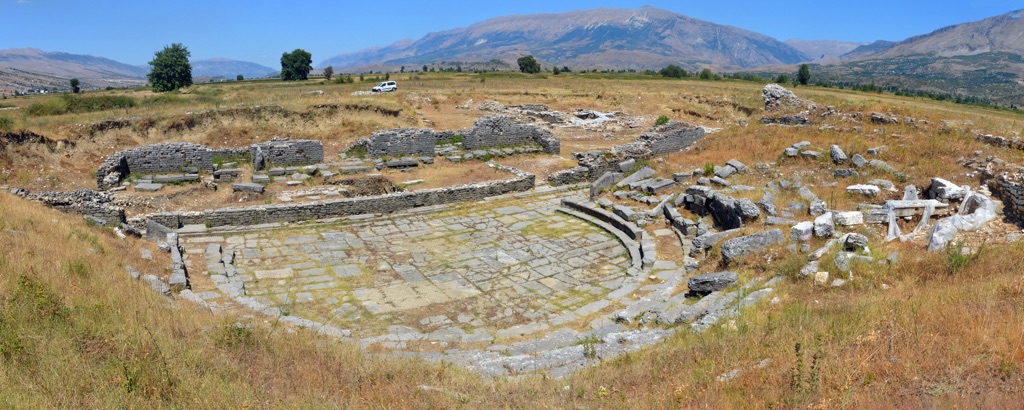Hadrianopolis, an ancient city located in the modern-day Eskipazar district of Karabük Province in Turkey, was once a thriving center during the Roman and Byzantine periods. Named after the Roman Emperor Hadrian, the city’s ruins were rediscovered in the 20th century, revealing a rich tapestry of history and culture. Its remains include public baths, a basilica, streets, and intricate mosaics, offering a glimpse into the past. The city’s strategic location and historical significance have made it a subject of interest for archaeologists and historians alike.
Get your dose of History via Email
Historical Background of Hadrianopolis
Hadrianopolis was established during the Roman Empire’s zenith, named in honor of Emperor Hadrian. The city’s discovery came much later, in the 20th century, when local farmers stumbled upon remnants of its past. Archaeologists, including R. M. Harrison and David French, took interest and began excavations in the 1980s. They unearthed a city that had witnessed various cultural influences and rulers over the centuries.
The Romans built Hadrianopolis, and it flourished under their rule. It later became part of the Byzantine Empire, continuing to thrive. The city’s location on key trade routes contributed to its economic and cultural prosperity. Over time, it was inhabited by different civilizations, each leaving their mark.
Hadrianopolis was not just a bustling trade center; it also played a role in religious history. It is believed to be the martyrdom site of Saint Alypius the Stylite. The city’s basilica is thought to have been dedicated to him, attracting pilgrims and contributing to the city’s religious significance.
Despite its past importance, Hadrianopolis eventually fell into decline. The reasons are not entirely clear, but it likely involved changing trade routes and regional power shifts. By the time of the Ottoman Empire, the city had been largely forgotten, buried under layers of history.
Today, Hadrianopolis is an archaeological site that provides valuable insights into the past. Its discovery and excavation have shed light on the Roman and Byzantine eras in the region. The city’s history, from its founding to its decline, reflects the broader narrative of the ancient world’s ebb and flow.
About Hadrianopolis
Hadrianopolis was a city of considerable architectural merit, showcasing the Roman Empire’s engineering prowess. The ruins include a complex of public baths, a basilica, and a network of streets. These structures were built using local stone, and the city’s layout followed the classical Roman grid pattern.
One of the most striking features of Hadrianopolis is its mosaics. These intricate artworks depict various themes, including mythology and daily life. They are a testament to the city’s artistic achievements and the skill of its craftsmen.
The public baths of Hadrianopolis were not just places for cleanliness; they were social hubs. Built with hypocaust systems, they provided heated rooms and hot baths, a luxury in the ancient world. The baths’ remains give us a peek into the leisurely aspects of Roman life.
The basilica, another significant structure, was likely a center for Christian worship. Its size and design suggest it was an important religious site. The basilica’s architectural highlights include columns and arches, common in Byzantine ecclesiastical buildings.
Overall, Hadrianopolis’s construction methods and building materials reflect the era’s typical Roman and Byzantine styles. The city’s architectural remains are invaluable for understanding the period’s urban planning and construction techniques.
Theories and Interpretations
Hadrianopolis has sparked various theories regarding its use and significance. The city’s mosaics have been particularly subject to interpretation. They are believed to represent not just artistic preferences but also religious and social themes of the time.
Some experts suggest that Hadrianopolis was a pilgrimage site, especially due to its association with Saint Alypius the Stylite. The basilica’s dedication to him supports this theory. However, concrete evidence of this remains elusive.
The mysteries of Hadrianopolis extend to its decline. Some historians theorize that economic changes or natural disasters contributed to its downfall. Yet, the exact causes are still debated, with archaeological evidence providing clues but no definitive answers.
Dating the city’s ruins has been a challenge. Archaeologists have used methods like stratigraphy and typology of artifacts to estimate the periods of occupation. These techniques, while helpful, have limitations and often require cross-referencing with historical records.
Despite the uncertainties, Hadrianopolis continues to be a site of scholarly interest. Its ruins offer a canvas for interpreting the past, and ongoing research may yet reveal more about this enigmatic city.
At a glance
Country: Turkey
Civilization: Roman and Byzantine
Age: 2nd century AD – 8th century AD
Conclusion and Sources
The information in this article about Hadrianopolis has been sourced from reputable references, ensuring accuracy and reliability.
Sources:

